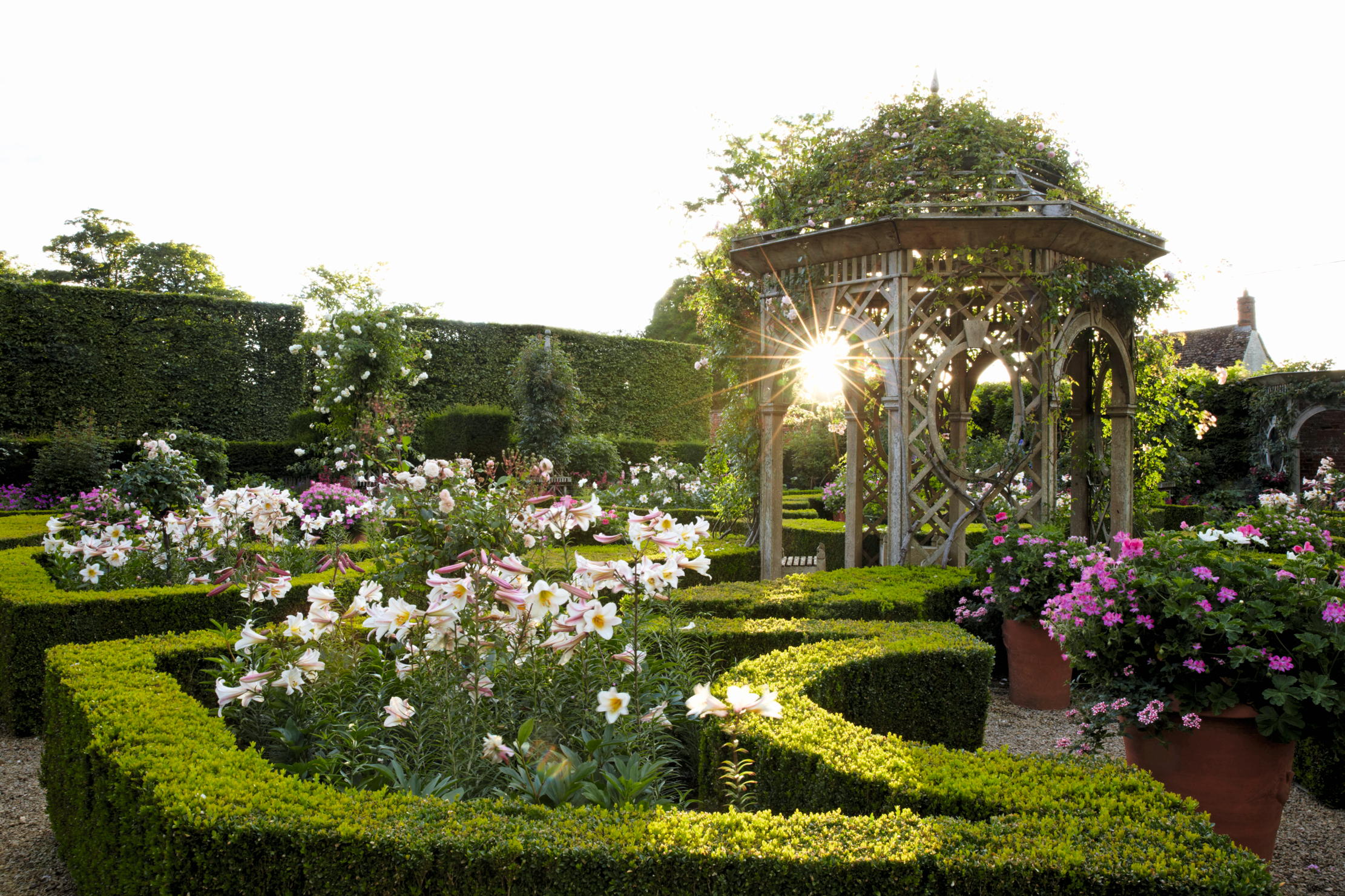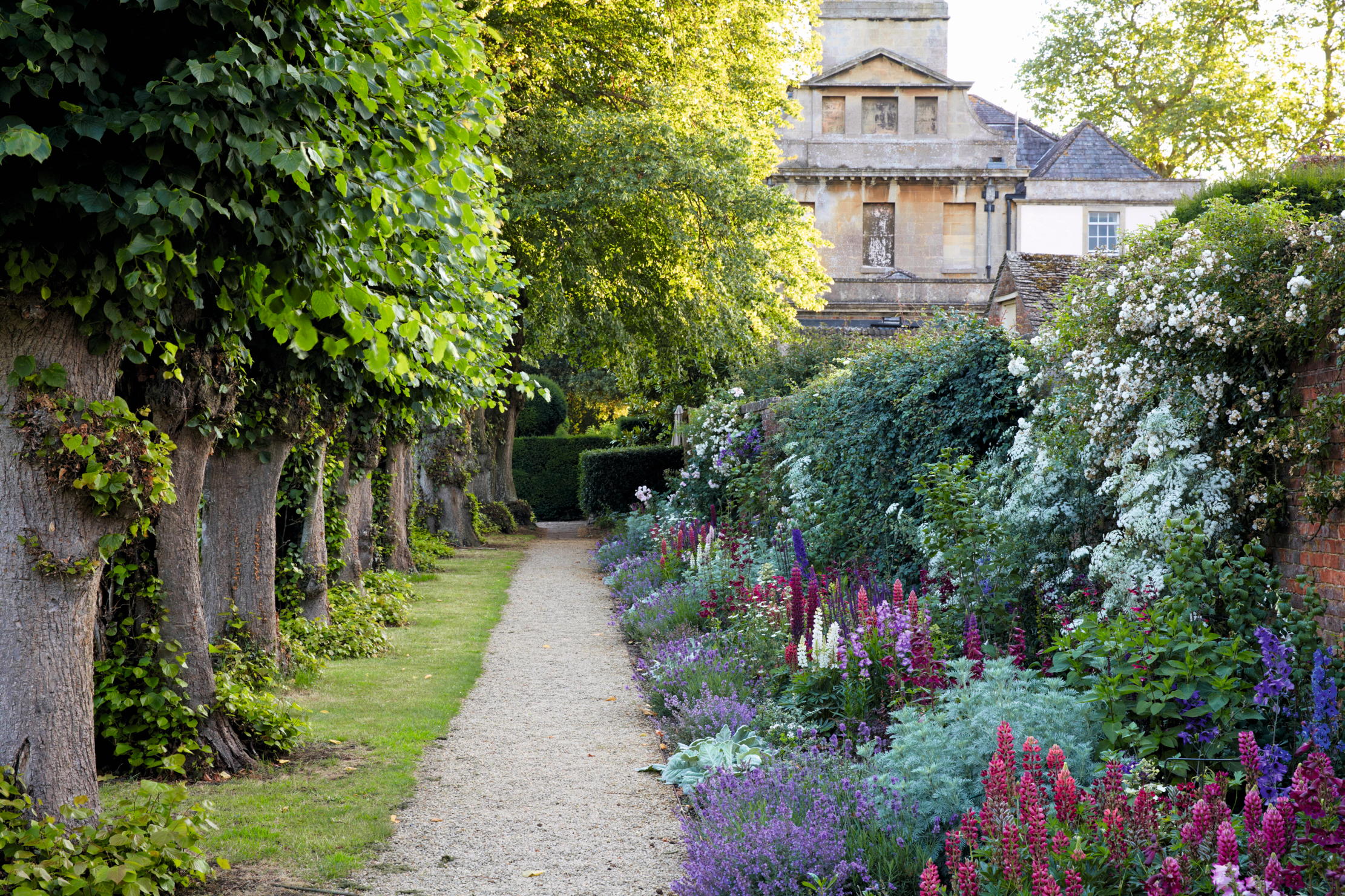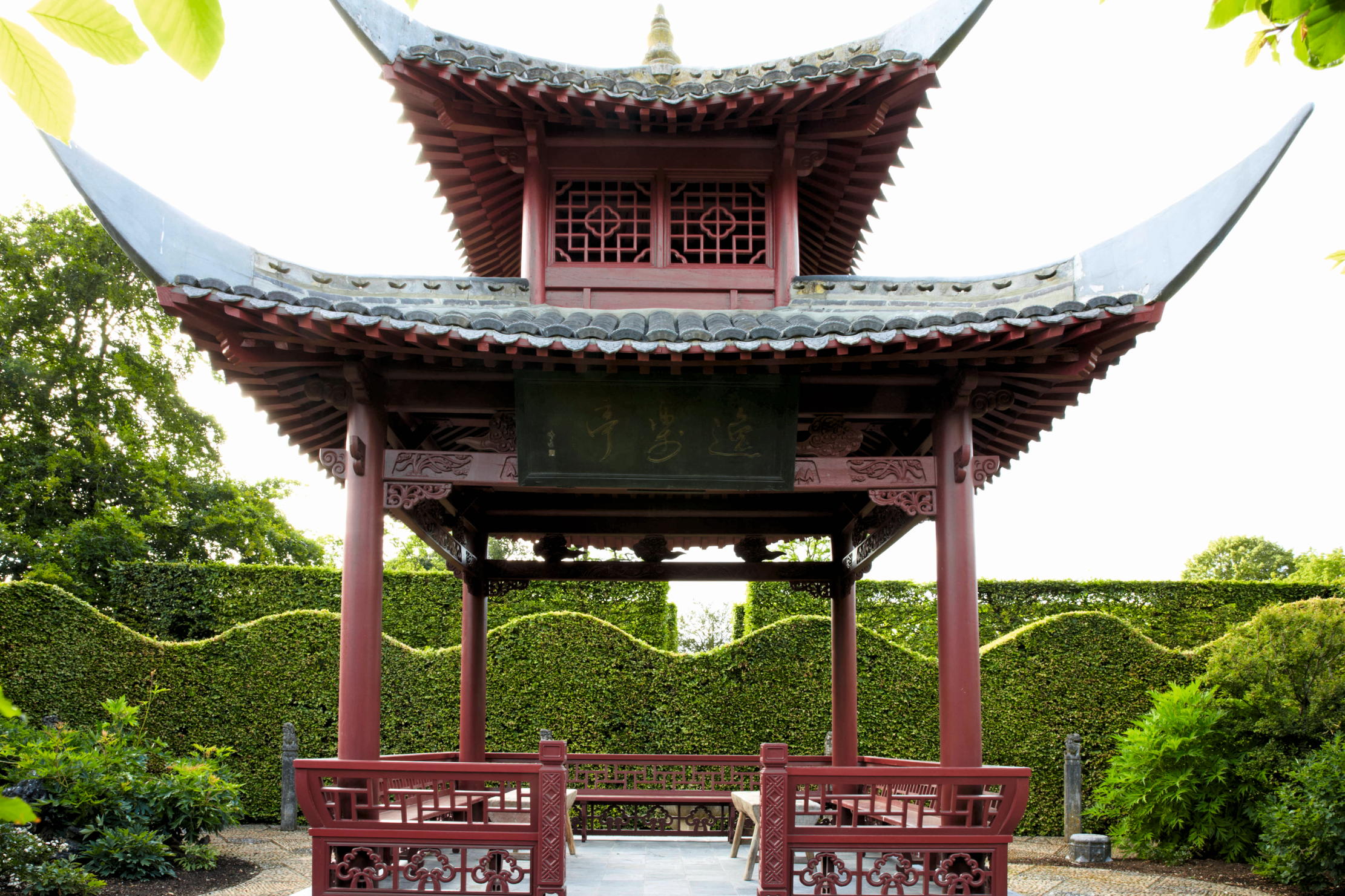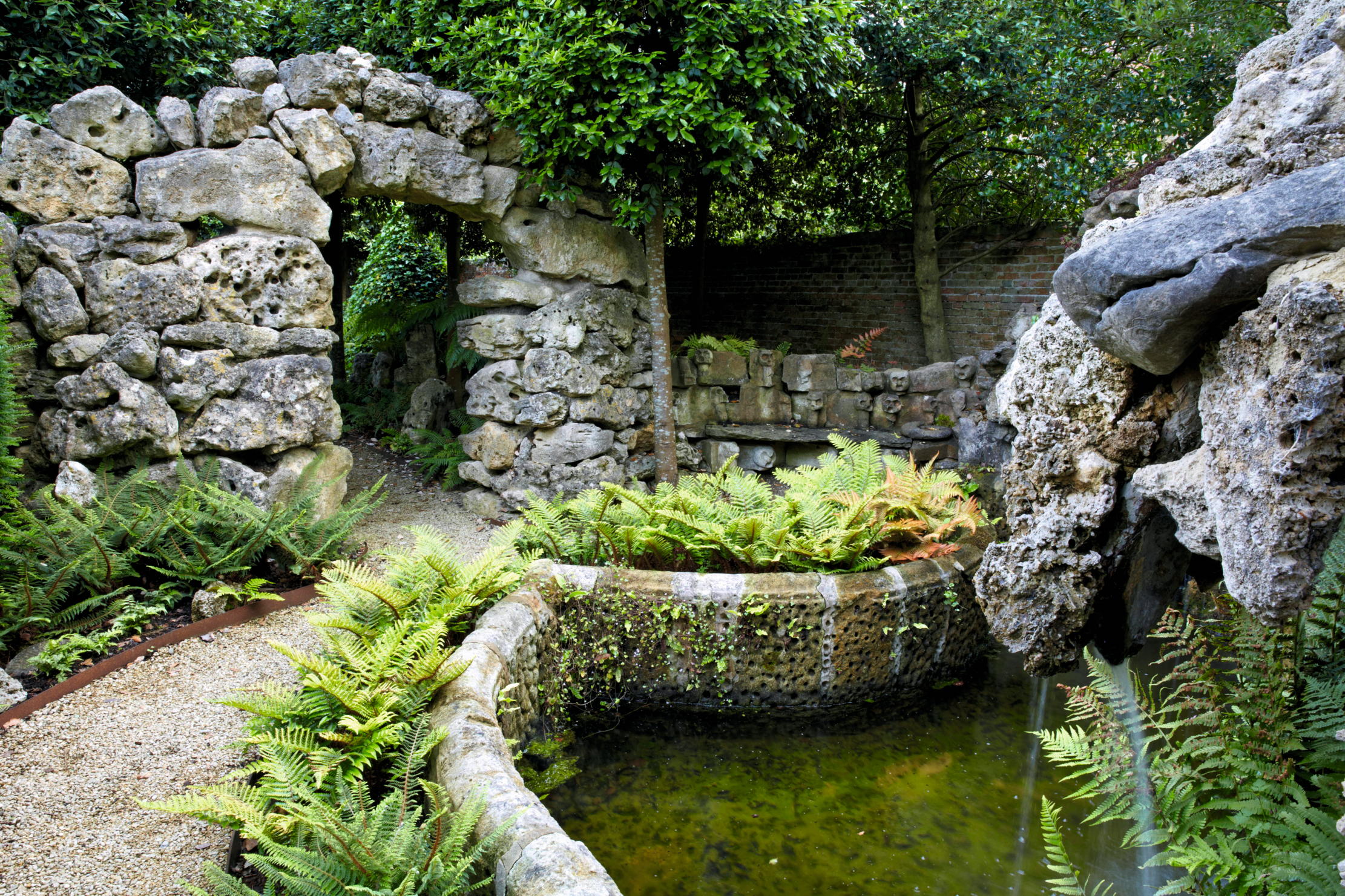A English country garden that brings the four corners of the world to one corner of Wiltshire
England, Africa, Italy or China — it’s possible to travel the world without leaving this imaginatively designed garden, which divides into four distinct geographical sections, each with a resonance for the owners. Caroline Donald reports from the garden at Seend Manor in Wiltshire, home of Amanda and Stephen Clark.

On a sunny day, Amanda and Stephen Clark hang out by their pool in Italy for the afternoon with a good book. From there, they can move to England for a sundowner, breathing in the heady scent of hundreds of roses in the parterre, before brushing their way through the copious growth of Spanish reeds (representing maize), cannas and bananas surrounding a South African hut. ‘Let’s go to China,’ they might then decide, meeting up with their nephews and nieces, who live next door, for Peking duck in the shade of an impressive, double-height ‘ting’ pavilion.
Instead of owning a supersonic jet, Mr and Mrs Clark have given these names to the four highly distinct areas they have created in their large walled garden at Seend Manor in Wiltshire. There is rhyme to their seemingly quirky reason: ‘It just seemed so nice to think of places we love,’ explains Mrs Clark. They are among the last of the colonial generations: Mrs Clark grew up in Hong Kong and Mr Clark, an investment banker, was born in Kenya and worked in South Africa. Bringing to mind the romance of an English country garden is what keeps them going in hotter climes — ‘It is the England of your dreams’ — and Italy ‘is where everybody falls in love and goes on honeymoon,’ themselves included.

As each area tries to capture the essential spirit of a place, the whole evokes a Persian paradise garden, divided into distinct quarters and with water — the river of life — at its centre. A magnificent Chilstone fountain, with an obelisk surrounded by sphinxes and gunnera, represents the source of the Nile.
The late MP Alan Clark and his wife, Jane, owned Seend Manor, a fine Georgian former hunting lodge, in the 1960s and 1970s, when the walled area was used as a kitchen garden. Subsequent owners planted it up ornamentally, but it had obviously been too much and, when the present Clarks arrived in 1998, it was overgrown with huge leylandii and 30ft-high hedged paths. ‘You couldn’t walk through them,’ recalls Mrs Clark. ‘There was a little swimming pool in the corner, but we didn’t find it until everything was removed and the beautiful listed brick walls were revealed.’

As there was little of value, save for a young beech hedge enclosing an oval area, in the south-western corner, it could all be removed, giving the Clarks a 1½-acre tabula that was pretty much rasa on which to work.
That the world has come to their doorstep is the result of the fertile visual imaginations of the couple, working with the designers Isabel and Julian Bannerman. The two men had been at Downside together and Mr Clark read history and history of art at university. ‘Julian and Stephen had great chemistry and were really creative,’ says Mrs Clark. ‘They drew out the best in each other.’

As to what to do in the walled garden: ‘It really was quite big, so we decided to divide it up. We started with the idea that the spaces would be very different from each other.’ As the Clarks still spend part of the year in Hong Kong, it’s important that it should be low maintenance, with the mantra ‘clip and mow’.
Exquisite houses, the beauty of Nature, and how to get the most from your life, straight to your inbox.
The garden has been developed slowly and organically, rather than being put in all at once, often being informed by bits and pieces that the Bannermans would find along the way. ‘There was a great deal of serendipity about things that came up,’ says Mrs Clark. ‘They knew lots of people who had odd stones, old brick and Spanish holey stone, which ended up lining a grotto in a shady corner.’
The loggia in ‘Italy’, for example, came about because the Bannermans were offered three Bath-stone arches, so they designed the building, which discreetly houses a changing room and little kitchen, around them. That then dictated what they were going to do with the rest of the space, including the long pool, the Yorkstone terrace and the pebble work around the parterres.

The women worked together on ‘England’, where peonies and scented delights, such as roses and philadelphus, are in great abundance. In the early days, the Clarks tended to be at Seend in June, but, as they are spending more and more time here, the early-flowering roses have been supplemented with modern repeat flowerers, lilies and scented-leaf geraniums to keep the perfumes pumping out through to September. Mrs Clark owns Altfield, one of Hong Kong’s largest multi-line design showroom and antique businesses, so had access to workshops in Asia that could create structures such as the gazebo and 14ft-tall teak obelisks supporting climbing roses, still standing after 25 years.
Even if the visitor doesn’t go through the metal gates that lead to the walled garden, there is still much to admire and inspect elsewhere, such as the new long border the couple developed during lockdown.

With the likes of ‘Masterpiece’ lupins, Salvia ‘Nachtvlinder’, ‘Patty’s Plum’ poppies, lavender ‘Munstead’ and highly scented evergreen Daphne x transatlantica ‘Eternal Fragrance’ to add punctuation marks, it has a punchy palate of purples and rich pinks. ‘We wanted really strong dark colours and the planting to be more “structural” than in “England”,’ says Mrs Clark. To complement this, white ‘Sanders Rose’ and pale pink ‘Blush Noisette’ climb the wall behind.
On the other side of the wall is the productive kitchen garden, designed by Mr Clark. ‘The most sensible thing we did here is the raised beds, so you can weed as you get older,’ he explains. There is also a cottage with its own garden, the borders edging a lawn, where Mrs Clark’s mother lived latterly. ‘She died during covid and I have completely redone it, so it is a soft, billowing cottage garden, which I am really pleased with,’ says Mrs Clark. In time, should the big house and garden get too much, the couple would happily move there. ‘We are not leaving,’ they promise.
Caroline Donald is a gardening writer, author and former gardens editor of The Sunday Times, as well as a regular contributor to Country Life.